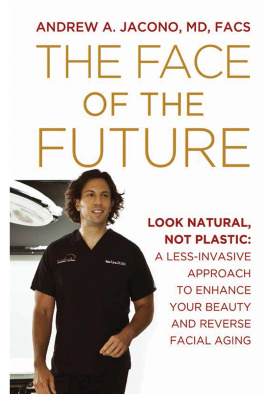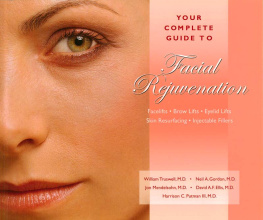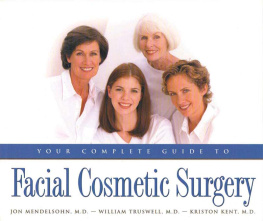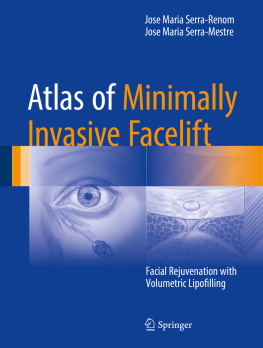An Addicus Nonfiction Book
Copyright 2012 by Andrew A. Jacono, M.D., F.A.C.S. All rights reserved. No part of this publication may be reproduced, stored in a retrieval system, or transmitted in any form or by any means, electronic, mechanical, photocopied, recorded, or otherwise, without the prior written permission of the publisher. For information, write Addicus Books, Inc., P.O. Box 45327, Omaha, Nebraska 68145.
ISBN 978-1-936374-87-8
Cover design by Gary Wong, interior design by Jack Kusler
Illustrations by William M. Winn, M.S.
Cover photo by William Hereford
This book is not intended to serve as a substitute for a physician, nor is it the authors intent to give medical advice contrary to that of an attending physician.
Library of Congress Cataloging-in-Publication Data
Jacono, Andrew A., 1970
Face of the future : look natural not plastic : a less-invasive approach to enhance your beauty and reverse facial aging / Andrew A. Jacono.
p. cm.
Includes bibliographical references and index.
ISBN 978-1-936374-87-8 (alk. paper)
1. Face--Surgery--Popular works. 2. Surgery, Plastic--Popular works. 3. Beauty, Personal--Popular works. 4. Skin--Care and hygiene--Popular works. I. Title.
RD523.J35 2012
617.520592--dc23
2012021553
Addicus Books, Inc.
P.O. Box 45327
Omaha, Nebraska 68145
www.AddicusBooks.com
Printed in the United States of America
10 9 8 7 6 5 4 3 2 1
Contents
When Good Temporary FIllers
and Botulinum Toxin Go Wrong, and How to Fix Them
To my beautiful children, Andrew, Arianna, Gavin, and Tallulah. You make every day of my life a dream and give each day meaning and purpose. I love you with all my heart.
Acknowledgments
I would like to thank my many friends and colleagues who have assisted me in my development as a surgeon; the American Academy of Facial Plastic and Reconstructive Surgery for its dedication to advancing research and education in plastic surgery; the fellows whom I have trained for their hard work and curiosity, which has helped me continue to evolve as a surgeon; and Dr. Vito Quatela, my fellowship director, for giving me the foundation on which I built my career.
I also thank my dedicated staff, Georgette, Diane, Harriet, Cathy, Joyce, Diana, Nicole, Lana, Cindy, and Peggy, for taking such good care of my patients and me. A special thanks to my patients for urging me to write my second book.
Introduction
M y overriding goal as a facial plastic and reconstructive surgeon is to deliver the best natural-looking results with minimal downtime, scarring, and risk for my patients. To that end, I am continuously evaluating my results, then innovating and creating new techniques to improve the outcomes and experience I can offer.
Unlike facial enhancing and rejuvenating procedures of years past, todays methods, I believe, should have the goal not to make everyone look the same, but to unlock the potential that exists in every persons face. This is where science meets art.
In my quest I have found that applying the principles of aesthetic balance from the Renaissance period to plastic surgical treatments has given my patients more-beautiful results while maintaining their identity. By better defining beauty, and applying these concepts to noninvasive, minimally invasive, and more-invasive surgical treatments, the results of plastic surgery leave patients in my practice looking natural, more attractive, more youthful, and more rejuvenated but never manipulated.
My approach combines minimal incision and endoscopic surgery to reposition the deeper facial tissues that droop with age, rather than stretching the surface of the skin, which makes plastic surgery look artificial. For those who want to enhance their beauty by changing the size and shape of their eyes, cheeks, lips, or nose, we combine science with art by employing the principles of the Golden Proportion, which you will read about in .
The purpose of this book is to empower you, by providing you with the information you need to make educated decisions about facial cosmetic procedures. It contains in-depth discussions about all of the state-of-the-art lasers, devices, injectable materials, and minimally invasive surgeries available. Specific attention is paid to focusing on what makes a potential patient a good candidate for different treatment, and the benefits and limitations of both nonsurgical and surgical techniques.
Welcome to The Face of the Future.
Andrew A. Jacono, MD, FACS
Facial Plastic and Reconstructive Surgeon
PART I.
Characteristics of Beauty
The greater danger for most of us lies not in setting our aim too high and falling short, but in setting our aim too low, and achieving our mark.
Michelangelo Buonarroti
1. The Celebrity Factor
I mages of thin, toned, celebrities with perfect faces puts enormous pressure on women, starting as early as their preteens. It is no longer good enough to keep up with the Joneses; many younger women feel that they have to keep up with celebrities. But of course that is not realistic. This pressure is not exclusive to women. Men are similarly being held to the celebrity standard; rock-hard six-pack abs and a chiseled jaw and cheekbones are an expectation that is difficult, if not impossible, to meet.
The Ideal Look
The ideal look has changed dramatically over the decades. If you look across cultures and throughout time, beauty standards have certainly evolved, but some aspects of beauty remain constant. For example, the pursuit of symmetry and balance in the face has stood the test of time, even though different ethnicities desire different eyelid, nose, and cheek shapes to maintain their heritage.
Standards of beauty are also very different between the sexes. The beauty ideal for female skin is universally lighter than for males across all cultures. The ideal female face is heart-shaped with a petite jaw, an arched brow, and full lips. Due to a decline in the feminizing hormones estrogen and progesterone as women age, they tend to take on a more masculine appearance. The face becomes square due to cheek volume loss and formation of jowls. Brows flatten, facial hair appears, and lips thin out. The physical traits that can make a man look rugged or handsome tend to make a woman appear more masculine, angry, and tired.
But men are not immune to aging either. Their brows and upper eyelids droop, and lower eyelid bags form, making them look not rugged but tired. As the neck loosens, men appear not only older, but also look as if they have gained weight even if they are in good shape.
Focus on Celebrities
Our cultures focus on popular media and celebrity has affected the way we perceive ourselves. A recent study from Harvard University found that Our society narrowly defines beauty by what we see in entertainment, advertising and fashion runways so that only 2 percent of women consider themselves beautiful, 5 percent consider themselves pretty, and a mere 9 percent even consider themselves attractive.
This study was based on quantitative data collected from a global survey of 3,200 women from Argentina, Brazil, Canada, France, Italy, Japan, Netherlands, Portugal, the United Kingdom, and the United States. Amazingly, 60 percent of women in this study felt that society expected them to enhance their physical attractiveness. It is no wonder why cosmetic surgery is on the rise! Unfortunately, I do not see our culture changing in the near future, and my goal in this book is to help you to navigate an ever-growing number of options (both nonsurgical and surgical) to enhance your appearance and look great.











